
You can click on any image on this page to see a larger version. Every photo was taken with a digital camera.
One of the amazing things about Burning Man is the amount of "eye candy". If you had been walking around your neighborhood at home and had seen almost any Burning Man art, you would have taken a photo. I only had a limited amount of "digital film" with me, so I had to be a bit selective.
If you're impatient, there are a lot of art photos at the end, and I've specifically put a "Naked People Warning!!!" in front of any that you might like to avoid (or see).
It was a great experience for us, too, up until our final day when we learned that Ellyn's mother had died suddenly. She had been ill for nearly a year, but in the month before Burning Man she had recovered significantly and the cause of death was completely unrelated to her previous illness. It's too bad that our first Burning Man experience will always be associated with this terrible occurrence, since otherwise I'm sure we would also be among the thousands of people who are totally ecstatic about it. A very important part of Burning Man is the Temple of Joy (described later on this page) which is built specifically for people who have recently lost a loved one. If we return to Burning Man next year, we will no doubt celebrate her mother's life in the temple and dedicate our art to her.
We had planned to stay for the entire week from Monday to Sunday, but we learned about the death on Friday at about noon, and were able to get everything packed and leave within about an hour and a half, with many thanks due to old and new friends who helped us make a quick exit.
In spite of the quote above (which is true) that I heard over and over before I went, I'll try to do the impossible, and at least explain the basic idea.
Here's a sample of a "small" piece of art we found. Ellyn is
standing next to a giant brain in front of some camp. Being a
neurologist, Ellyn couldn't resist being part of this photo. Her
hand is on the left occipital lobe.
A high percentage of the attendees are dressed in interesting and sometimes fantastic costumes ranging from sea serpents to fantasy animals to body paint only, or nothing at all. I'm afraid that Ellyn and I were not particularly visually interesting, but at least we did produce some art.
During the week before the burn, The Man stands out in the center of everything, and glows with a sort of neon-bluish glow. It can be seen from almost anywhere in camp, and thus it is not hard to orient yourself. On the other hand, the first night there I walked out to visit The Man, and had a slightly difficult time finding my way back. Although it's easy to head for The Man, almost any direction away from The Man looks the same, especially at night, and especially when everything is new.
People there told me that perhaps more interesting than the burn
itself is the fact that during the burn, large crowds of
pyromaniacs are nearby, making huge flames and explosions of
their own with home-made blow-torches, propane guns and God knows
what else.
In my own perverse way, one of the big attractions of Burning Man
is the fact that things are not necessarily safe. In fact, the
first thing that appears on the entrance ticket is, "YOU
VOLUNTARILY ASSUME THE RISK OF SERIOUS INJURY OR DEATH BY
ATTENDING." The last thing on the ticket is also important:
"PARTICIPATE".
A friend of Ellyn who had attended numerous times told us about her first visit with her boyfriend who had been there previously. She said that shortly after entering, they were passed by a giant truck decorated to look like a dragon, and it was belching huge balls of flame from its mouth. Riding on it was a large group of crazed individuals who all seemed out of their minds. Gasoline was leaking all over the place and she said it looked dangerous as hell. She knew that Burning Man had a safety committee to make sure that nothing too dangerous occurred on the playa, so she asked her boyfriend how the safety committee had ever given the OK to this deathtrap, He replied, "That is the safety committee, riding on the dragon."
I wonder how many injuries occur, due to the "Disneyland effect". In our litigious society, everyone assumes that when they go to a place like Disneyland, that all of the rides, although they may look dangerous, are, in fact, totally safe—checked by experienced safety engineers to assure that the danger is absolutely minimized. That assumption would not be a good one at Burning Man. You never know who built anything, or how competent they were. (Surprisingly, however, almost all of the artists I talked to seemed extremely competent.)
One of the folks in our camp, Kenny, was working on an extremely interesting item. Apparently Kenny is quite creative, and in past years has come with flame-throwers and other exciting things. This year, he had decided that he would like "to be able to jump over cars." So in the bed of his truck, he built a tower that was perhaps 20 or 25 feet tall, with an extension on top out to the sides so that its extremities were outside the truck bed. Hanging from the extensions were bungy cords which could be attached to a belt. The wearer of the belt would run along the ground next to the truck as it drove across the playa, and since each step would pull the runner into the air, he could take "steps" that were 15 or 20 feet long each, and the truck could therefore travel at 20 miles per hour.
There were enough bungy cords so that the runner could leap 15 or 20 feet in the air, and thus jump over cars or other similar obstacles on the playa. Unfortunately, we never got to see it in action, but a couple of hours before we left, it looked like it was almost ready to go. I asked Kenny how he was planning to find a victim to take the first test run, and he said, "No problem. I'm married to that victim." I'm sure it would have been a wonderful thing to see, but I doubt you'll ever see one in use at Disneyland.
Every year there is a theme for Burning Man, and in 2002, the theme was "The Floating World". Thus, most of the art had to do with oceans or water, although there were plenty of other things as well. Apparently it was a very good theme since almost everyone can figure out something to do with it. The year before, the theme had been, "The Seven Ages of Man", which proved to be a bit more difficult for the artists.
One thing is certain. Unless you are a complete maniac, no
matter what you build, someone else there will have built a
bigger, more fantastic version of the same thing. A case in
point is an "obvious" floating world object: the rubber ducky.
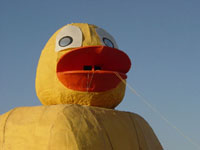
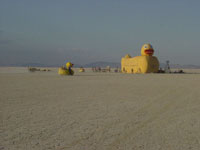
Behind the ducky was a casino, and inside the ducky was a disco
that played dance music from midnight to 4:00 am.

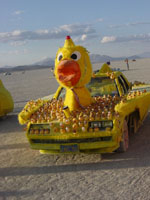 At least I think this was the largest and most spectacular
rubber ducky at Burning Man, but of course one can never be
sure. On our first trip out to visit the ducky, we were amazed
to see that the same idea had occurred to at least five other
people. There was a parade of five art cars, all of which were
models of rubber duckies, on a mission to visit the great rubber
ducky on the playa. So all five of those art car designers were
one-upped by the giant ducky of the playa.
At least I think this was the largest and most spectacular
rubber ducky at Burning Man, but of course one can never be
sure. On our first trip out to visit the ducky, we were amazed
to see that the same idea had occurred to at least five other
people. There was a parade of five art cars, all of which were
models of rubber duckies, on a mission to visit the great rubber
ducky on the playa. So all five of those art car designers were
one-upped by the giant ducky of the playa.
It was quite a festival when the ducky cars arrived—they
drove around and around the great ducky, and finally parked in a
row. One of the art cars was covered with "normal" rubber
duckies, and of course someone had a powered little ducky that he
let loose on the playa.
Everyone told us that conditions at Burning Man are brutal—no water, dust, wind, and heat. The festival is held in the Nevada desert perhaps 120 miles northeast of Reno. The Burning Man organization provides only the minimum. There is a grid of roads and porta-potties available. The only things you can purchase are coffee-type drinks and ice. Other than the coffee and ice, nothing else is for sale, and all other commercial activities are forbidden.
The anti-commercial aspect was strictly enforced near "center
camp"—the center of most activity. If you had rented a
truck to bring your stuff, you were required to modify or cover
up the advertising painted on the truck. Some people simply
modified the text: "Budget" was changed to "Fudget", for
example. Our camp was required to cover the logo on our truck
which took us a few hours to do, given the huge size of the
truck. We tied a tarp over the outside of the truck whose body
was about nine feet high, but which started about three feet off
the ground. It was crowded, and even when we managed to toss
cords over the top of the truck, it was often difficult to get to
the other ends since other campers had set up structures that
almost touched the truck.
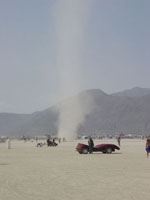
When we got home, there is no quesiton that there had been a lot
of dust. I cleaned and cleaned, and am now certain that for the
next year I will, from time to time, find little pockets of playa
dust here and there.
We got exactly three reactions when we told people we were going: "I've never heard of Burning Man.", "Why on earth are you going? It's just a bunch of drug addicts, perverts, and naked people.", or "That's wonderful! You'll have a great time!" Other than people who had never heard of it, we got exactly zero neutral reactions. Actually, come to think of it, maybe the folks with the third reaction above assumed that Ellyn and I were naked, drug-addicted perverts.
There certainly were plenty of folks who were clearly not in a "normal" frame of mind, and also plenty of naked people. In fact, one piece of advice we received was that as soon as we arrived, we should set up our tent. We should not look at all the naked people. If we don't get the tent set up, we could die; there will always be plenty of time to look at the naked people. After not too long, seeing naked people all over the place became normal.
Actually, I'm not sure there were many "normal" people
there—almost everyone was "subversive" in one way or
another. I'm certain John Ashcroft would have been very
uncomfortable, since it would have been very difficult to find
enough draperies in the Black Rock desert to cover the hundreds
of naked people wandering around. I'm certain that Ashcroft
would have liked nothing better than to drop a nuclear bomb on
that portion of the Nevada desert to kill 29,000 enemies of his
police state. There may, however, have been quite a few cases of
severe sunburn, possibly enough to kill a few of us without
Ashcroft's help.
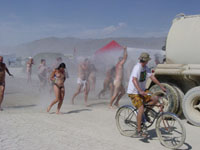
But for many people, the water truck represented a free shower,
and people lined up along the roads, waiting for it to come. As
soon as it passed, they would run along behind it until they were
exhausted, trying to get splattered by as much water as
possible. I'm not sure it was effective; although the top parts
of their body perhaps got a bit cleaner, everything below the
knees was splattered with mud. But it was always a spectacle.
But it's almost certain that somebody among the other 29,000 campers will have it, so all you need to do is to find that person and barter for it.
Although there is some bartering, there is also a huge component of the economy that is purely gift-giving. Our camp gave away cooling mists. Another camp gave away pancake breakfasts, others delivered messages (that would be "Ped-Ex"), you could obtain free beers or margaritas from the truck next door, there were free massages, free body painting, and there were people all over the place offering a free puff or two of their "cigarettes".
When Ellyn and I had to make our speedy exit, we entered into the gift economy in a big way, and unloaded lots of water, soft drinks, beer, and gatorade.
It's a nice way to live, even if it's only for a week.
We bought our tickets a couple of months before Burning Man, so we had plenty of time to get all our stuff together. Of course, having so much time, we started on some projects are were far more ambitious than we should have; namely, our art project, the octavepus.
But in addition to the art, it was necessary to plan for a camping trip that was unlike anything either of us had ever done before. The main problem was water—you have to bring all your water for drinking, washing, bathing, or whatever. In the spirit of Burning Man, where everything worth doing is worth over-doing, we over-did the water. We took two 5-gallon plastic bottles that are used in water coolers, a 15-gallon drum, two cases of 12 1.5-liter bottles of water, two cases of Gatorade, two cases of soft drinks, and a case of fruit nectar.
Fluids were not the only excessive thing we did. We got a big, six-person tent because there is a lot of space out there, and it's good to be able to put your stuff inside to protect it from the dust. The tent came with a set of tent pegs that are about seven inches long and an eighth of an inch in diameter, but we had been assured that if set up with those, in a 70-mile-per-hour dust storm our tent would be flying, so we brought our own tent pegs—2-foot lengths of 1/2 inch diameter rebar that we pounded almost all the way into the ground with the sledge hammer that I brought. What I did not bring was a method to remove the rebar from the playa and many minutes of hammering sideways on the stakes only loosened them a bit. We finally borrowed the miracle tool for playa rebar removal—a pair of vice-grips.
For the octavepus art project, I took spare everything—extra logic chips of every sort, an extra microcontroller, a soldering torch, wire strippers, wire cutters, extra wire, and so on. In fact, when we first set up the octavepus, one of the banks of lights wasn't working, and Jeff, the fellow camped next to us, said that it was too bad that we hadn't had the problem the previous year, since last year he could have loaned us a multimeter. I replied, "Well, obviously I've got a multimeter." Most people don't think to take one on a camping trip, although I'll bet there were hundreds of multimeters on the playa.
I also took complete octavepus documentation. This included lists of the color-coding of the wires, a manual for the microcontroller, sheets with the pin-outs of every chip, diagrams of how the tentacles hooked to the van, et cetera. I figured (correctly, it turns out), that anything I brought along those lines I would not need, and I did not want to need any of those things. I even took a laptop that I would need if I decided to reprogram the octavepus. I wrapped it in many layers of plastic and kept it sealed in the bottom of a plastic bin, hoping that I would never have to take it out (and I didn't).
We were moderately reasonable about everything else. We brought plenty of food and plenty of clothes, sleeping bags, cooking stuff, fuel, et cetera. Well, maybe we were also a bit excessive about the amount of food, but we figured we could always take it home and eat it later.
We had no idea how difficult it would be to wash dishes on the playa. Burning Man is a minimal impact camp, and the goal was to leave nothing behind, including gray water. At every meal, we'd try to figure out how to minimize the number of dishes involved. Ellyn and I ate off the same plate, and if possible, didn't use a plate at all but rather ate out of the cooking device. Modern camping foods often come in their own cooking packet which is ideal.
I was very impressed by the lack of trash, and it seemed like almost everyone took it seriously. Even after four days on the playa, camping with 20,000 other people, it was not easy to find trash scattered about. Every now and then you'd see a water bottle or a scrap of paper, and when that occurred, most people would just pick it up and stuff it in their own trash bags. Every campsite I have ever seen in the Sierras is far filthier, even if it is only large enough for a couple of tents.
Here's Ellyn on her bike out on the playa with the main camp far
in the distance.
The Roller Disco Camp
When you go to Burning Man, there is a huge amount of space for
camping and most of it is available except for the stuff right
near center camp (the circular region at the 180 degree line from
The Man—see below). The map shows all the "streets" at
Burning Man, arranged in a partial circle around The Man. The
angles are obvious, and the numbers on the streets correspond to
distance (in feet) from the man. This year, due to the nautical
theme, the streets had names as well as numbers, with 2100 being
the Esplanade, and others mostly named after parts of
ships—Mizzenmast, Bowsprit, et cetera, and the outermost
street at 3900 feet from The Man was called "Abyss".

The main attractions were along Esplanade, in center camp, and in the two smaller centers of attraction at 90 and 270 degrees at about 2100 feet. Anyone could camp almost anywhere on Abyss.
Ellyn and I figured that it would be more interesting, although perhaps noisier, to camp near the center, but to camp there, you pretty much need to be associated with one of the theme camps. Friends who had been there the previous year had told us we could camp with them in "Emerald City", a camp devoted to the support of a huge laser, but as the days grew shorter, it became clear that Emerald City would not exist in 2002.
A different friend, Rolf, had told us that he was going to camp with the "Desert Nose" people, said we might want to camp with him, and sent a pointer to their web page. Well, when I got to that web page, I discovered that the camp was really responsible for two things. In addition to the Desert Nose, they ran the Roller Disco, which was, miraculously, the only other camp at Burning Man that I knew anything about. The folks who run the Roller Disco are mainly associated with a company, CoolNeon in Oakland, California, that sells the electro-luminescent wire which I used heavily in my octavepus art project. I had spoken with the CoolNeon folks on the phone a few times to figure out the details of my orders and to get some electrical specifications on the wire and electrical drivers for it. They told me how much fun the Roller Disco camp was and that I should be sure to stop by.
Anyway, Ellyn and I applied to be in that camp and were accepted. The Roller Disco is located in center camp near the 165 degree line at about 2500 feet from The Man. We couldn't ask to be much more central than that.
It was a great place to be. Although we knew only Rolf to begin with, everyone was friendly (actually, almost everyone we met at Burning Man was very friendly). Howard, the guy nominally in charge of the camp, was very helpful, and he got us squared away quickly. In exchange for living in the camp, we had volunteered to do work, either in the Desert Nose or the Roller Disco, or something related. Since we left early, we probably didn't do all the work we'd promised, but we did do a fair amount.
The Roller Disco is just a roller-skating rink that is built out in the middle of the playa. Since the playa is basically flat, almost all that's required is to anchor down a set of 4x8 foot boards, one next to the other. Then there's a disc jockey (usually David Miles, the guy who runs the "Friday Night Skate" in San Francisco), a sound system, a lighting system, and a set of sofas in the middle of the rink. There's also an entry where people can borrow roller skates, and Paul Schissel (the owner of a big skate rental shop in San Francisco) had brought 60 or 70 pairs of various sizes to loan out. Skaters who had been to Burning Man the previous year knew about the Roller Disco and brought their own pairs of skates.
One of the big jobs that Ellyn and I did was to try to sort out the skates, which were just piled into boxes, into pairs and arrange those by size when the Disco opened the first night. Then we helped people select skates, and tried to put the skates back in the right places when people were finished. It took a lot more time than I'd thought, since a lot of the skates look the same, and since they'd been heavily used, a lot of the size information was pretty hard to read.
But people really seemed to enjoy skating, and there were a lot of quite good skaters who stopped by. Some of them were naked, of course.
The Desert Nose is a totally inspired concept. It is a sort of geodesic dome that is modified to take the shape of Buckminster Fuller's nose (Buckminster Fuller is the guy who invented geodesic domes which were everywhere on the playa). Inside the nose are a bunch of couches where perhaps 15 people can rest, and in the center is a place where people are misted with water. They used the sprayers of the sort that are used to spray lawns, et cetera, and just a little water in a mist can cool you off impressively.
A guy named "Gorilla" (who looked a bit like one) did most of the spraying which usually occurred during the hottest part of the day. We'd stand outside and talk people into coming in to get sprayed, but after a couple of days, there were plenty of return customers and word of mouth generated all the business we could handle. Howard brought about 250 gallons of water, and it wasn't completely clear at the time we left whether that would be enough to get through Burning Man.
This is the only camp where I got to know the people very well, but I was quite impressed at the number of very technically competent subversives we had. In conversations, I learned a huge amount about construction, electronics, explosives, and fire. I don't know if the other theme camps were that way, but I suspect that many of them were. Most of the people I met had gone to big name colleges and universities (like Yale, Brown, Caltech, Stanford, and Harvey Mudd).
The Octavepus
I decided that if I was going to Burning Man, I might as well go
whole-hog and do an art project as well. A year earlier, Rolf
had shown me electro-luminescent wire (or EL wire), and I loved
it, so I decided that whatever I did, it would somehow involve
that wire.
EL wire is basically a flexible wire that glows in the dark and resembles neon lighting, although it's obviously a lot thinner. Locally, it's available from the CoolNeon company mentioned above. It's made of a metal wire core, surrounded by a substance that glows when a high voltage (120 volts works well) is applied across it. Surrounding the glowing substance are a couple of spiraling hair-thin wires, and they carry a voltage that is 120 volts different from the core. Since we were using batteries to power the whole thing, we used inverters and a transformer to get alternating 120 volt current to power the wires. Finally, the wires are covered with translucent colored plastic, and the color of the plastic determines the glowing color.
Originally, I'd thought of just having a bunch of banks of lights on the surface of the octopus, and to have a sequencer run through patterns of those lights. In fact, sequencers are available from CoolNeon, but most of them have fairly simple-minded patterns. I decided that it would be cool to have a microcontroller (basically a microcomputer) that ran the lights that I could control exactly as I wanted. Besides, if I built my own sophisticated sequencer, I'd learn a little something about digital electronics.
Well, one thing led to another, and Ellyn had the wonderful idea of running the lights not only from a computer program, but also manually from a piano-type keyboard. Since there are 8 banks of lights and 8 notes in an octave, it seemed perfect. She's the one who suggested the new name, "octavepus". Each note would cause a particular bank to glow, and chords would cause "chords" of banks to glow.
But there are only 7 notes in an octave (or 12, if you count the "black" ones). But no matter. I just hooked the notes to banks of lights in order, and different versions of the note "C" played different banks. It worked fine. I suppose I could have done some research on what chords are most common and to make certain that those chords made pretty combinations of light, but maybe next year.
Of course it is impossible to capture the true glowing nature of
the CoolNeon electro-luminescent wire on film, digital or
otherwise.
It turned out that I was too stupid to be able to figure out how
to get an electrical connection between the MIDI output of the
cheap Radio Shack keyboard and my microcontroller, and as time
was running out, I did what any good electrical engineer would
do: I cut a hole in the bottom of the keyboard, installed
switches under each of the white keys and attached a cable with 9
wires from the keyboard to the microcontroller. Then I added a
bit of logic that "OR"ed together the keyboard and
microcontroller outputs and added a circuit that caused the
microcrotroller to stop sending signals if the keyboard was
active. If nobody played a note on the keyboard for a few
seconds, the microcontroller would conclude that the keyboard
player had died, and would begin again playing its light patterns.
Since the construction of the octavepus was going to take a while, I wrote a simulator program that allowed me and friends to write patterns for the octavepus and to view them in action on the computer screen. I wrote a little language that looks a bit like musical notation (tempo settings, chords, rests, whole notes, half notes, quarter notes, et cetera) to describe patterns and by the time I went to Burning Man there were perhaps 70 patterns the octavepus could play. The complete language is described in the detailed description of the octavepus. In addition to the pretty patterns, another inspired idea from a friend was to give the octavepus the ability to flash out messages in Morse Code. This was easy to add, and intermingled with the pretty patterns, the octavepus blinked out a number of messages, some of which were not particularly complimentary to certain individuals in the current administration.
When I got the real octavepus running, almost all the patterns designed on the simulator worked fine, but I did tune most of them. One error I made in the design of the language was that I set the default tempo to 120 quarter notes per minute. I found that over and over again I changed that to be faster. I chose a tempo of 132 to match the normal speed of trance music which I figured would be very common at Burning Man. This was also a great idea; a number of people thought that the octavepus was blinking in time to the ambient music. If they were properly "tuned" to the trance music, it's easy to figure out why ...
We powered the whole thing with a "lawn tractor" battery (like a miniature car battery). In retrospect, it would have been better to get a "deep cycle" battery, but this one worked fine, and since the Roller Disco camp was in center camp, we were actually on the tiny "power grid" for Burning Man, and I could recharge the battery every night. I had planned to recharge it by running the van's motor for a bit each day if power had been unavailable.
Each evening when the sun went down, we'd power up the octavepus and let it run until about 4:00 am. (Well, until whenever we woke up and had to pee.) After turning it on, we usually hung around for about an hour to talk to passersby about it, and got quite a few compliments. Luckily, we were parked on a fairly major road (the 165 degree radial road) very near both center camp and the Esplanade, so there were a lot of visitors.
The Other Octavepus
The Burning Man webpage
contains descriptions of many of the art projects that were
proposed by various people. Ellyn was looking through it, and
discovered, to her horror, that someone else was already building
an octavepus. I expected a million octopusses, but was surprised
at an actual octavepus. Of course when we were there we made a
pilgrimage to see the other octavepus, and although the idea was
quite a bit different, it was quite cool in its own way.
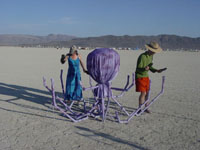
The Temple of Joy
One of the larger constructions at Burning Man is the Temple of
Joy. This is the third year that it has appeared, and it is
dedicated to those who have lost a loved one. It is made
completely of wood, and is burned on Sunday, the day after The
Man is burned.
During the week, people enter the house and write inscriptions to
the dead, leave remembrances, and so on. When we arrived, work
was still progressing, but when it was complete, the temple was
always thronged with people. It was one of the most popular
installations.
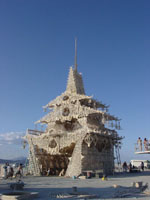
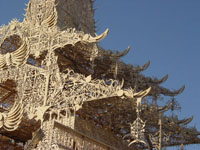
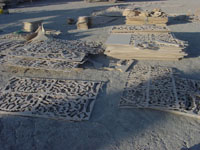
We were not there for the burning of the temple, but there did appear a story in the San Francisco Chronicle about it. What was bizarre about the Chronicle story is that it basically said that the temple was built to honor those who died on September 11. In fact, I guess a box containing all the names of those victims was inside the temple, and that the fire was lit by a fireman, but in all the time I spent at Burning Man, there was not a single mention of September 11 by anyone, including the builder. It's nice that the victims were honored in this way, but I think it's pretty misleading to imply that this was the main reason for the construction of the temple. The temple was there for everyone, certainly including the September 11 victims, but I'm sure that the vast majority of the prayers that were said and written were for Burning Man loved ones.
We were a bit late this year to honor Ellyn's mom, but next year we will.
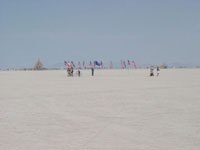
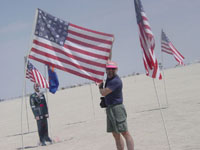
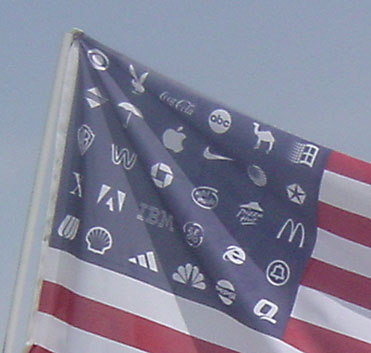
I apologize for the left image. It was taken by a helpful woman
I met at the display, but her photographic skills are a bit
lacking. The horizon is not exactly perfectly
level.
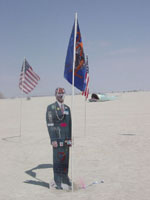
Actually, the photo may be worthwhile since if you look closely
(or look at the larger version of the image), there's a fairly
cool fish art car in the background.
It certainly is a fantasy world, but if you go to the opera, or to a movie, or watch television, or go to Disneyland, or go to church, you're doing essentially the same thing and you never hear people say that those are "just fantasy worlds". In fact people contribute directly or indirectly millions of dollars to those fantasies.
From a "practical" point of view, there are only three things that really matter in our world: Eat, Survive, and Reproduce. Due to the heat, there may have been slightly less eating going on at Burning Man than is normal, but there was a heck of a lot more surviving and reproduction than you'll see in any church or movie theater (well, maybe not on-screen, but at least among the audience members).
Everyone inside the dome was dressed in Mad Max costumes, the audience was chanting, "Two men enter, one man leaves!!!" over and over, there was fire and smoke, a loudspeaker was playing at tremendous volume the "Ride of the Valkyries" from Wagner's opera "Die Walküre", where the Valkyries descend to earth to carry fallen warriors from the battlefield up to Valhalla where they can fight and feast for eternity. In addition to being packed around the outside of the Thunderdome, people had climbed up the sides and formed a spherical shell of humanity around the action. The dome was huge—perhaps 80 or 90 feet in diameter.
Unfortunately, the action takes place at night, so I didn't have my camera, and it would have been tough to get images anyway, but almost everyone watching was really into it. Anyone could be a gladiator, but you had to bring your own opponent.
The two fighters were strapped into belts hooked by bungy cords to the top of the Thunderdome so every step bounced them high in the air. In addition, the controllers could yank on the cords and lift the combatants off the ground. Each was provided with a padded stick and they really got into slamming each other. From time to time, the "referee" would signal, and monstrous Thunderdome helpers with their faces full of metal would yank the two combatants back to the edges of the dome where they'd let them go to swing by the bungy cords into each other.
We did run into a strange character there who really didn't fit the Burning Man mold. He seemed highly concerned with the safety of the fighting and especially for the safety of the people who had climbed up on what he called "that experimental structure". Well, "that experimental structure" was a Buckminster Fuller geodesic dome, and from my point of view, it was ridiculously over-engineered. The grid size was tiny and the bars were extra heavy duty. I don't think there was a safer structure in all of the Burning Man camp.
You had to keep your wits about you as you walked or rode your bike on the playa, since the cars were wandering everywhere with the drivers in an unknown state of inebriation. In addition, especially out on the playa, there were art installations that were not lit, some of which were supported by guy wires that were totally invisible at night. I saw one guy crash into a road sign one night, and I narrowly missed a few art installations out on the playa. Bike helmets? I didn't see a one...
Of course everything was under total control (if you believe in Disneyland). Once you entered the camp, you were not allowed to move your car unless you got special permission from the Burning Man "DMV". That's "Department of Mutant Vehicles". I think we could have gotten permission for the octavepus plus van, but with the octavepus in place, it was impossible to see out the windshield. I doubt that the minor matter of being unable to see would have deterred the DMV from giving us a license.
Anyway, here's a small gallery of art car images, which would have included the rubber ducky cars except that they are displayed above.
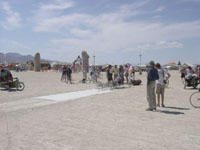
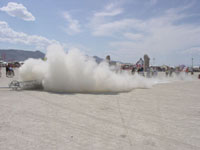
Then the pressure is suddenly released, and the car speeds out onto the playa. Miraculously, I was able to catch the car just as the pressure was released in the image on the right. This photo on the right also provides a nice demo of the playa dust.
On this particular launch, the driver's helmet got wedged by the acceleration into the metal grating behind his head. Whiplash lawyers would have a field day if only this were Disneyland.
Notice that the phallic car shape is matched nicely with the pair
of structures in the background.

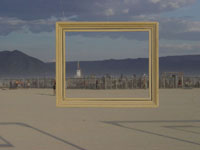
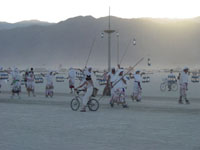
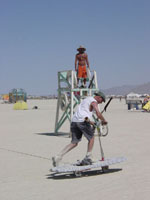
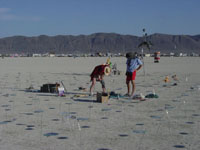
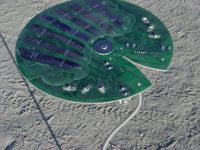
Each pad is equipped with solar cells and lights, and it can communicate with adjacent pads via infra-red transmitters. As you walk through the pond, the broken infra-red connections signal to the pads to make "waves" with the lights.
When we visited, the communication part was not yet working, and
I'm not sure if it ever did.
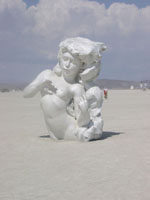
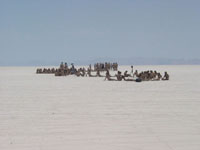
Here's another
photo of the mud people. Apparently, the planning
for this event wasn't so good ...
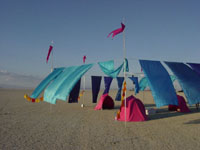
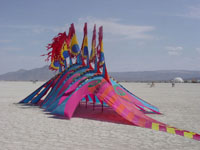
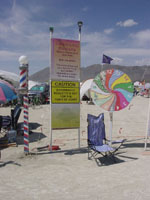
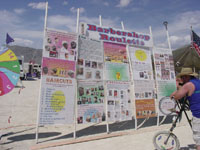
Even with the large version of the image on the right it is a bit
difficult to see the list of possible haircuts, but they include,
Crewcut, Fade, Bowl or Mushroom, Mohawk, Shaved Head,
Businessman's Cut, The Infamous Barber's Choice, Mid-American
Mullet, Color Spray, High and Tight, Flat Top, Initials or Symbol
Cut, No Haircut, and Spin Again. To the right of the list on the
big board are sample photos of each type of cut.
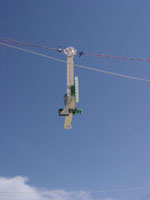
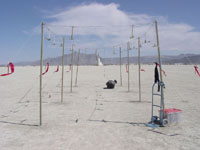
What happens at night is amazing; the sticks spin, so the LEDs each trace out a path of light. But each LED is controlled by a tiny computer, and it is switched on and off as it spins to draw ghostly images or text messages in space. Some were multi-colored and some not. In some, the text appeared to move through space as if it were on one of those old news tickers attached to buildings 30 years ago.
Here's an image of a close-up of one, and of the entire group. I
do not, unfortunately, have a photo taken at night, so you'll
just have to imagine what it looked like.
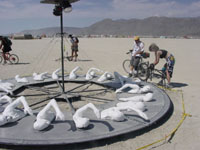

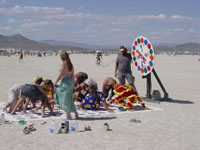
Want to send me mail? Click here: tomrdavis@earthlink.net.
Return to my home page.